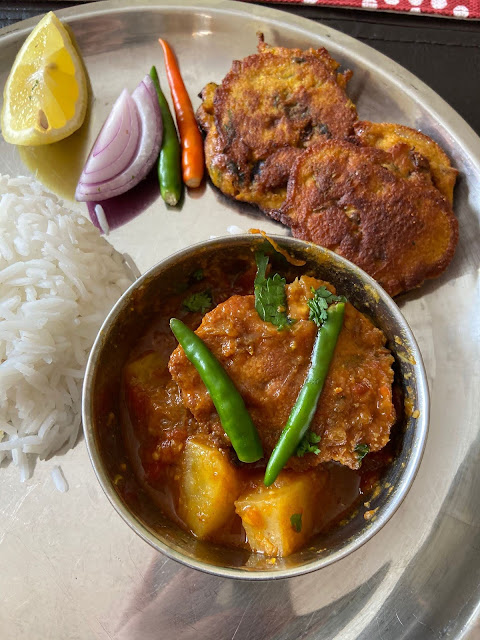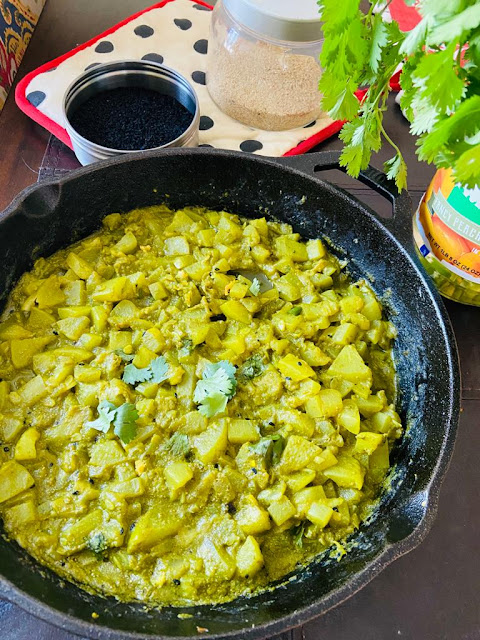Peper Shukto | Raw Green Papaya Shukto
Shukto, in Bengali cuisine holds a very important place as a palate cleansing starter to a gourmet meal. Dating back in origin to the medieval period (as mentioned in Mangal-Kavya, shukto recipes might vary over time and region but a bitter vegetable is always the mainstay. The more common Bengali shukto is cooked with a mélange of vegetables. This very different Pepe Shukto made by my mother, has grated raw green papaya and bitter gourd, both vegetables having immense medicinal qualities and is the perfect start to a meal on a summer day.
Some people cook a lot in times of stress. I am not one of them. I think my Mother is.
Last year, when India went into lockdown during Covid, I had suggested that my parents get food delivered from a caterer. A friend suggested a home caterer recommended by her elderly parents in the same area as my parents. There was some initial resistance from my parents,
My Mother had always cooked all our meals as far back as I can remember. She never liked the idea of a cook and on the few occasions that she had one, she couldn't wait to get rid of the "cook" person. Naturally she was not very eager about this home delivery. However I was getting worried about them going out for daily grocery, vegetables, fish etc. during Covid and so the home delivery seemed like a wise decision at that point. Simple Bengali dishes, cooked at home by the gentleman's wife, enough for two meals for my parents.
Surprisingly, they soon took to the home delivery, in particular the person who ran the business, and on occasions my Baba would even praise the cooking. "Enchorer torkari ta besh bhalo korechilo, laal rong hoyechilo jhol tar," my not-interested-in-food Baba would say over the phone.
Many of you know that I was in India in the later part of last year. The home delivery was still continuing. The food was good but for someone like me, who cooks mostly in Olive oil and always chooses low-oil options, the aloo-potol er dalna with a slick layer of oil floating on top or the jackfruit curry with a shimmer of oil like a placid lake, was too much for everyday meals. The oil was not in excess for those used to full course Bengali/Indian meals but I realized it was me, whose food habit had changed with time and environment,
So to complement the food delivered with healthier options, I started popping across to the small store across our housing complex, every other day to get some vegetables that could be steamed or boiled. I bought the same vegetables every time -- a raw papaya (pepe), a couple of bittergourd, carrots, green chilli and lime. I would then add all these vegetables to a pot of lentils and boil them together, to make a dal with vegetables. I was in no mood to do anything more.
One day for lunch, I saw a beige colored vegetable dish with a bay leaf peeping out for lunch. It was not from the home-delivery tiffin carrier. My mother sheepishly admitted, that she had made Pepe'r Shukto. I had never heard of it. Neither did I understand the point of making hundred different types of shukto.
Maybe my mother got tired of the raw green papaya and bittergourd that I would always steam with the lentils, maybe she just wanted to do something that would keep her mind busy, maybe she wanted to be engaged again in her kitchen, to go back to a routine...I don't know. What I admired was that with so many things going on, she gathered strength to grate a raw green papaya, chop bittergourd and make a dish which was far more complex than the boiled fare I had been doing all along!
I have never been fond of any kind of shukto ever but I have started making this Pepe'r shukto often. My friends and the husband-man seem to love it. In my mother's version it is more sweet than bitter and with a generous amount of ghee, it could pass off as an almost dessert!! Naturally, my version has less sugar and ghee but if you want be generous with those.






